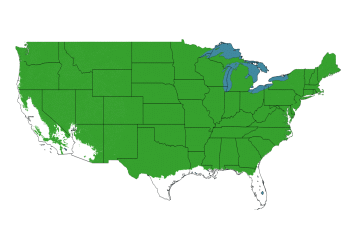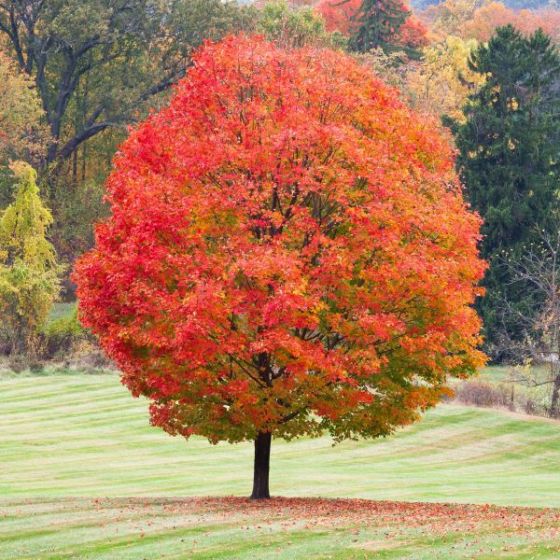✖
Outstanding Fall Color, Sweet as Sugar Maple Syrup
- Yellow, Orange and Red Autumn Color
- Edible Sap
- Makes Scrumptious Maple Syrup
- Fast Growing
- Supports Nesting Birds
- Hardy
Sugar Maple (Acer saccharum) is a deciduous tree known for brilliant fall colors and sap that is the primary source for maple syrup. For over 300 years, the Sugar Maple has played an important part in the diet of many Americans.
The native Americans who had been enjoying the attributes of this wonderful fruitful plant for centuries, were quick to share it with the early North American settlers. John Smith, leader of the Virginia Colony at Jamestown in the early 1600's, was one of the first to report about this tree that produced an outstanding sugar substitute.
When the dark green leaves turn a vivid eye-catching yellow, red and orange in autumn, you'll understand why Sugar Maple is best known for its spectacular fall beauty. Imagine flaming crimson, burnt orange and brilliant yellow displayed on the Sugar Maple all at the same time!
The effect of the variety of changing colors will dazzle you and your neighbors. It is one of the most remarkable fall displays of color you will see in your neighborhood.
Sugar Maples are one of the most incredible landscape trees available for several reasons. They quickly grow straight and true with a rounded crown that's not only attractive for your yard but perfect for supplying a little shade on a summer day.
Unlike a lot of trees, Sugar Maple will do well even in the shade of other trees in your yard, and it won't mind heat or drought. It's adaptable to many conditions.
Sweeter than the syrup of other Maple Saps like the Black Maple (Acer nigrum) or the Red Maple (Acer rubrum), the Sugar Maple sap produces syrup that is less cloudy and of higher quality than the others.
It's so easy to drain off some sap as it rises in early spring and boil it down. Give samples of your syrup to friends and family!
Sugar Maples are also prized for their wood. It's very hard and dense, making it a good choice for everything from furniture to flooring.
Magnificent fall color, beautiful and hardy shade tree, delectable maple syrup...any one of these features would make the Sugar Maple an outstanding choice for your yard. In short, the Sugar Maple has it all so order one for yourself today!
How to Use Sugar Maple in the Landscape
Use a single Sugar Maple tree as an incredible shade tree in the lawn. Give it plenty of room to grow into its full mature height and spread.
With those shallow Maple roots, it's best not to plant too close to concrete. Plant it 30 feet away from sidewalks, driveways or patios.
If you have the room, and are entrepreneurial-minded, try growing them in a large orchard to provide a cash crop. March and April are sugaring season, when the warmer temperatures encourage the tree to convert stored starches into sugar.
Sap contains 2% sugar, and it takes about 40 gallons of sap to create a gallon of delicious maple syrup. Plan to sell your Maple syrup at Farmer's Markets and online.
For a continuous hedge, plant them 15 feet apart, measuring from trunk to trunk. The canopies of the trees will grow together in time.
To give each tree its own space to develop into individual trees, plant them 25 feet apart on center. No matter what size you order from LetsPlantify.com, you'll measure from the trunk of one to the trunk of the next.
You'll get a big jump on a mature tree by buying the largest container size we have in stock.
This is a perfect tree for lining a country road that sees less traffic. They make a magnificent stand where the trees can be spaced to let them reach maximum height and spread.
#ProPlantTips for Care
Barry Bonds had his best year of hitting home runs (73) in 2001 when he switched for the traditional Ash wood used for bats to bats made from the wood of the Sugar Maple.
Though adaptable to many soil conditions, the Sugar Maple prefers slightly acidic soils. It will not tolerate high saline soils. The tree can also be affected by heavily compacted soils and is very sensitive to air pollution.
In areas with higher pH soils, urban pollution and compaction, the Norway Maple (Acer platanoides) is recommended as a substitute.
The lovely native tree casts wonderful shade, becomes a home for your local songbirds, and delivers impressive fall color when the leaves turn yellow, orange and red. All that, and the chance to produce exquisite maple syrup? What a wonderful tree! Order your Sugar Maple today!
| Botanical Name | Acer saccharum |
|---|---|
| Mature Height | 50 - 70 feet |
| Mature Spread | 30 - 45 feet |
| Soil Type | Well-Drained |
| Moisture | Moderate |
| Sun Exposure | Full Sun, Partial Shade |
| Growth Rate | Fast |
| Bloom Period | Early Spring |
| Flower Color | Yellow |
| Foliage Color | Green |
| Fall Color | Yellow, Orange and Red |
| Pollinator Required | No |
| Pollinator Friendly | Yes |
| Growing Zone Range | 3-8 |

Write Your Own Review

